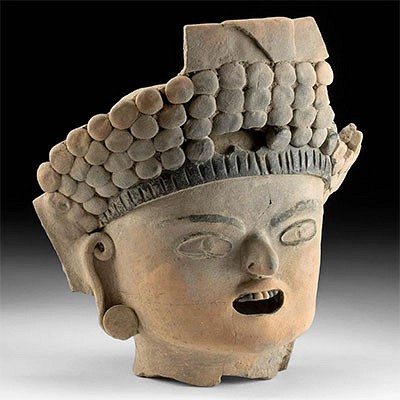Chinese Ming Glazed Pottery Horse w/ Groom Figure
Lot 113
About Seller
Artemis Fine Arts
686 S Taylor Ave, Ste 106
Louisville, CO 80027
United States
Selling antiquities, ancient and ethnographic art online since 1993, Artemis Gallery specializes in Classical Antiquities (Egyptian, Greek, Roman, Near Eastern), Asian, Pre-Columbian, African / Tribal / Oceanographic art. Our extensive inventory includes pottery, stone, metal, wood, glass and textil...Read more
Estimate:
$1,100 - $1,650
Absentee vs Live bid
Two ways to bid:
- Leave a max absentee bid and the platform will bid on your behalf up to your maximum bid during the live auction.
- Bid live during the auction and your bids will be submitted real-time to the auctioneer.
Bid Increments
| Price | Bid Increment |
|---|---|
| $0 | $25 |
| $300 | $50 |
| $1,000 | $100 |
| $2,000 | $250 |
| $5,000 | $500 |
| $10,000 | $1,000 |
| $20,000 | $2,500 |
| $50,000 | $5,000 |
| $100,000 | $10,000 |
| $200,000 | $20,000 |
About Auction
By Artemis Fine Arts
May 18, 2023
Set Reminder
2023-05-18 10:00:00
2023-05-18 10:00:00
America/New_York
Bidsquare
Bidsquare : Ancient | Asian | Ethnographic Art
https://www.bidsquare.com/auctions/artemis-gallery/ancient-asian-ethnographic-art-12797
Featuring classical antiquities, ancient, and ethnographic art from cultures encompassing the globe. Egyptian, Greek, Roman, Near Eastern, Asian, Pre-Columbian, Native American, African / Tribal, Oceanic, Spanish Colonial, Fossils, more! All legally acquired, legal to sell. Satisfaction guaranteed. Artemis Fine Arts info@artemisfinearts.com
Featuring classical antiquities, ancient, and ethnographic art from cultures encompassing the globe. Egyptian, Greek, Roman, Near Eastern, Asian, Pre-Columbian, Native American, African / Tribal, Oceanic, Spanish Colonial, Fossils, more! All legally acquired, legal to sell. Satisfaction guaranteed. Artemis Fine Arts info@artemisfinearts.com
- Lot Description
**First Time At Auction**
East Asia, China, Ming Dynasty, ca. 1368 to 1644 CE. A mold-formed pottery horse and an attending groom figure standing upon an integral rectangular plinth, both glazed in Sancai hues of amber yellow, brown, and green. The word Sancai means "three colors," and is achieved by different oxides mixed with varnishes then fired at low-temperature. The horse is saddled, and the groom may have been holding a lead at one time - patiently waiting for a rider to mount the horse. Tomb attendants like these are part of a class of artifacts called mingqi - sometimes known as "spirit utensils" or "vessels for ghosts." They became popular in the Han Dynasty and would persist for several centuries. Alongside steeds and servants, were musicians, athletes, warriors, and structures. Even though they were often mass produced, mingqi often show a high level of detail and naturalism. These were designed to assist the po, the part of the soul of the deceased that remained underground with the body while the hun, the other part of the soul, ascended. Size: 8" L x 3.3" W x 7.25" H (20.3 cm x 8.4 cm x 18.4 cm)
Provenance: private Hawaii, USA collection; ex-Roy Louis Byrnes (1924-2019) collection
All items legal to buy/sell under U.S. Statute covering cultural patrimony Code 2600, CHAPTER 14, and are guaranteed to be as described or your money back.
A Certificate of Authenticity will accompany all winning bids.
We ship worldwide and handle all shipping in-house for your convenience.
#178128Chips and nicks to surfaces and age commensurate wear and abrasions. Restoration to outstretched arm on groom using new material and glaze - repair is excellent and nearly indiscernible. Overall great condition.Condition
- Shipping Info
-
All shipping is handled in-house for your convenience. Your invoice from Artemis Gallery will include shipping calculation instructions. If in doubt, please inquire BEFORE bidding for estimated shipping costs for individual items.
-
- Buyer's Premium



 EUR
EUR CAD
CAD AUD
AUD GBP
GBP MXN
MXN HKD
HKD CNY
CNY MYR
MYR SEK
SEK SGD
SGD CHF
CHF THB
THB














